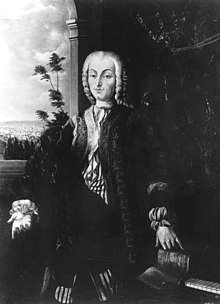Piano/Introduction

Introduction
[edit | edit source]The piano, attributed to Bartolomeo Cristofori of the eighteenth century, is a popular keyboard instrument widely used in western music for solo performance, chamber music, and accompaniment, and also as a convenient aid to composing and rehearsal. The piano produces sound by striking steel strings with felt hammers. These vibrations are transmitted though the bridges to the soundboard and projected acoustically through a soundboard. The piano has long been a crucial contributor to many musical genres, from classical to contemporary.
Etymology
[edit | edit source]The word piano is a shortened form of the word "pianoforte," which itself is derived from the original Italian name for the instrument, "clavicembalo col piano e forte"--literally "harpsichord with soft and loud." This refers to the ability of the piano, unlike the harpsichord, to produce tones at different volumes depending on velocity with which its keys are struck.
History
[edit | edit source]
By the 1650s, the harpsichord and the clavichord, two predecessors of the pianoforte, were arguably among the most used instruments in Europe. Composers at the time were upset with not being able to control musical dynamics, or, in simpler terms, the ability to make certain notes louder than others. By the eighteenth century, Bartolomeo Cristofori (1655-1731) created a mechanism by which dynamism could be achieved. Over time what he called the pianoforte gained traction, and soon made its way to upper- and middle-class families.
By the beginning of the 19th century, piano manufacturers experimented with piano assembly, thus greatly reducing the selling price of the piano. The famous 1920s saw piano coming into popular culture with musical styles different from that of the traditional classical pieces of music. The Great Depression, however, decreased the popularity of the piano and many piano manufacturers went out of business. But by the 1940s, the piano underwrote a rival of sorts, and the baby grand piano (smaller pianos) became extremely popular as a cheaper and more encouraging option to middle-class families.
By the 21st century, keyboards increasingly began to replicate the sound of acoustic pianos, and, just as baby grands in the 1940s, began to stand as another option, and continues to do so today.
Mechanics
[edit | edit source]
As a keyboard stringed instrument, the piano is similar to the clavichord and harpsichord in that all produce sound by causing strings to vibrate and are operated by striking black and white keys. The three instruments differ in the mechanism of sound production however. In a harpsichord, strings are plucked by quills or similar material. In the clavichord, strings are struck by tangents which remain in contact with the string.
In a piano, the strings are struck by hammers which immediately rebound, clear of the vibrating strings. Unlike the clavichord and harpsichord, the piano has mechanisms called a "dampers" to prevent the strings from vibrating indefinitely or causing sympathetic vibration in other strings. Each key on the piano has a felt damper that rests against the strings to stop unwanted vibration. When a key is struck, the corresponding damper pulls away from its strings, allowing those strings to vibrate freely until the key is released and the damper falls back on the strings for that key, stopping the vibration and thus stopping the sound. This, along with the ability to produce both loud and soft noise makes the piano the responsive and expressive instrument we love today and is one of the main reasons the piano has far surpassed the clavichord and harpsichord in popularity.
Significance
[edit | edit source]The piano is a crucial instrument in Western classical music, pop, jazz, rock, film, television and electronic game music, and most other complex western musical genres. It has also become the main instrument in many churches, supplementing or even supplanting the traditional church organ. Since a large number of composers are proficient pianists, the piano is often used as a tool for composition, such as solo piano pieces. Beethoven's "Fur Elise" and "Moonlight Sonata", Mozart's "Turkish March", Chopin's "Prelude In A Major" and ragtime pianist Scott Joplin's "The Entertainer" are some popular pieces for piano.
Pianos were, and are, extremely popular instruments for private household ownership, especially among the middle- and upper-class. Pianos have gained a place in the popular consciousness, and are sometimes referred to by nicknames, including: "the ivories", "the joanna", "the eighty-eight", and "the black(s) and white(s)." Playing the piano is sometimes referred to as "tickling the ivories".
